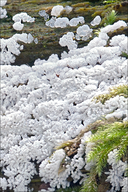|
|
click photo for larger file

Ceratiomyxa fruticulosa var. fruticulosa
Coral Slime Mold
|
Photographer: Dr. Amadej Trnkoczy
ID: 0000 0000 0716 2344 (2016-07-15)Copyright © 2016 Dr. Amadej Trnkoczy
|
|
INFORMATION PROVIDED WITH THE PHOTO
|
date of photo Jul 9, 2016
latitude 46.35258 longitude 13.69529
View on Google Maps.
location
Lower Trenta valley, between villages Soča and Trenta, left bank of river Soča, upstream from Trenta 46 house, East Julian Alps (Posočje, Slovenia)notes Slo.: paličasta hladetinka, rogata sluzavka - syn.: Byssus fruticulosa Müll. - Habitat: Fagus sylvatica forest with some Picea abies; moderately inclined slope at the foot of a mountain, northwest aspect; calcareous, skeletal forest ground; in shade; next to a river, humid air conditions; partly protected from direct rain by tree canopies; average precipitation ~ 3.000 mm/year, average temperature 7 - 9 deg C, elevation 525 m (1.720 feet), alpine phytogeographical region. Substratum: almost totally rotten tree stump; probably Fagus sylvatica, possibly Picea abies. Comment: Ceratiomyxa fruticulosa var. fruticulosa is one of the most distinctive and wide-spread myxomycetes (nowadays Protosteliomycetes). It is easy to recognize it since nothing similar exists outside tropical regions. Because of its bright white color, it is also easy to spot. Its genus name Ceratiomyxa comes from Greek words keras and myxa. The first means horn(s) and the second slime. And indeed it consists (in most cases) of many erects columns made of slimy substance. Unlike of all other myxomycetes the columns bear individual spores externally, on long stalks (see picture 2b, middle-left). However, it can appear also in a much different form, which is treated by some authors as separate species Ceratiomyxa poroides Alb. & Schwein or a subspecies of Ceratiomyxa fruticulosa. Then it looks like spongy, poroid or effused crust, much similar to some poroid basidiomycetes. The plasmodium of Ceratiomyxa fruticulosa is watery translucent (see picture 2a, slime among developed columns). It initially forms whitish blobs (see picture 1b, upper part), which in mature stage develop into simple or sparsely branched columns covered by stalked, white spores looking similar to glandular hairs of higher plants. Ref.: (1) B. Ing, The Myxomycetes of Britain and Ireland, The Richmond Publ. Co.Ltd, (1999), p 25. (2) S.L.Stephenson and H.Stempen, Myxomycetes, Timber Press Inc.(2000), p 93. (3) M. Poulain, M. Meyer, J. Borronet, Les Myxomycetes, FMBDS (2011), Vol.1., p 297.camera Nikon D700/Nikkor Micro 105mm/f2.8
contributor's ID # Bot_986/2016_DSC3646 photo category: Fungi - mold
|
MORE INFORMATION ABOUT THIS FUNGUS
|
| common names
Coral Slime Mold (photographer)
View all photos in CalPhotos of Ceratiomyxa fruticulosa var. fruticulosa Check Google Images for Ceratiomyxa fruticulosa var. fruticulosa |
|
The photographer's identification Ceratiomyxa fruticulosa var. fruticulosa has not been reviewed. Click here to review or comment on the identification. |
|
Using this photo The thumbnail photo (128x192 pixels) on this page may be freely used for personal or academic purposes without prior permission under the Fair Use provisions of US copyright law as long as the photo is clearly credited with © 2016 Dr. Amadej Trnkoczy.
For other uses, or if you have questions, contact Dr. Amadej Trnkoczy amadej.trnkoczy[AT]siol.net. (Replace the [AT] with the @ symbol before sending an email.) |
|
|
